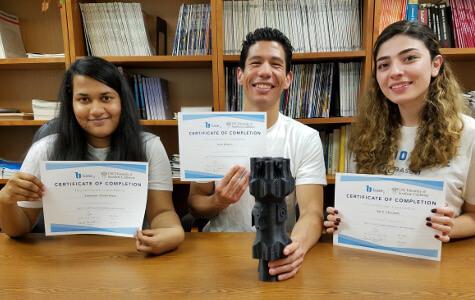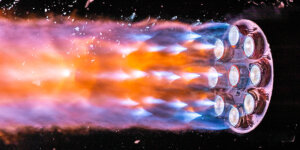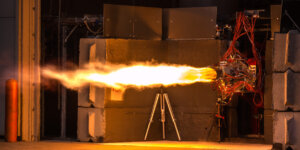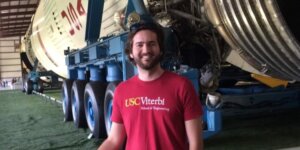On November 17, the student-run USC Liquid Propulsion Lab (LPL) gathered in Southern California’s Mojave Desert to execute the world’s first test fire of a student-built 3D printed rocket engine made entirely on campus.
The engine performed perfectly, proving their design and manufacturing methods are capable of withstanding the immense pressures of a combustion. This engine in particular, named James, experienced 725 pounds of pressure in its chamber, producing 600 pounds of thrust.
But it is just one in a fleet of 3D printed engines produced by LPL. The largest of which, called Balerion, is capable of 2,250 pounds of thrust and is planned to be tested for the first time in the spring.
“We’re learning all the steps that need to be done to make a static fire,” said Jan Fessl, co-lead engineer of LPL and master’s student in USC Viterbi’s Department of Astronautical Engineering. “We want to learn the process of engine development on these smaller engines, and then apply the knowledge to bigger engines like Balerion.”
Advanced manufacturing
Their engines are manufactured and built completely in-house at USC – a first for any 3D printed engine made by a student group. The parts are printed at the Center for Advanced Manufacturing using Inconel 718, a high strength nickel-based superalloy, and finished at the university’s machine shop.

LPL member Tai Wei (David) Chen working on their flagship engine, Balerion. Photo/USC LPL
“The challenge for us is not the precision, but in how best to approach the job, tooling and fixtures,” said Don Wiggins, the machine shop’s foreman.
The precision comes from 3D printing their engine. This enables them to design more complex architectures than would be possible with a machinist, allowing for better curvatures and geometries that increase engine performance. It also saves them a lot of time, letting them print a part in hours which otherwise would have taken months to machine.
“Traditional manufacturing relies on fixed tooling – think of casting molds or forging equipment. This makes it slow and expensive to modify a design. With printing, you can make those changes in software and go straight to printing your new design,” explained Jordan Noone, USC Viterbi alumni (B.S. AME ‘14), former lead of the USC Rocket Propulsion Lab, and CTO and co-founder of Relativity Space.
The innovative work being performed by LPL garnered attention from researchers and professionals over the summer. At the American Institute of Aeronautics and Astronautics (AIAA) Propulsion Conference in July, they showcased the design of their test stands and the objective behind their organization. More recently, at the International Aeronautical Congress in Bremen, Germany in October, they presented the design of their 3D printed engine.
Putting education first
While most rocket groups have their eyes solely fixed skyward, attempting to quickly build and launch rockets into space, LPL instead focuses on establishing professional work processes and a network of alumni and industry partners. Their primary goal is to provide an education and industry-like experience for their members.
“The main goal of the lab is to create an environment that people can grow themselves and then be able to get their dream job,” Fessl said. “If you build up the process, the results are going to come by itself.”
And this plan has already begun to pay off. In the three years since their founding, their alumni have gone on to work on the most challenging projects at major aerospace companies and startups including SpaceX, Northrop Grumman, Firefly Space Systems, Vector Space and Generation Orbit.

Base 11 students Tehreem Ahsan Raza, John Rogers and Serli Alexandi with their USC LPL internship certificate of completion and a plastic model of the James engine, which they worked on over the summer. Photo/USC LPL
Fessl estimates that he spends more than half of his time building the work force. One of the ways he does this is with Base 11 – a non-profit organization that brings together high-potential, low-resource community college students with world-class university and industry partners. This past summer, LPL mentored six community college students, taught them about rocketry and provided a hands-on learning experience through design projects.
One such student is Serli Alexandi who was hesitant about working with LPL due to her lack of experience with rocketry, “But because of the friendly atmosphere of the lab and encouraging behavior of my mentors, all my worries went away instantly,” she said.
Alexandi interned at the lab during the 2017-18 school year as a Glendale Community College student before participating in the summer fellowship. She is now a USC Viterbi student majoring in mechanical engineering and is an assistant test engineer at LPL.
“USC stands out in how it has adapted the summer Base 11 Fellowship program at LPL to focus on aerospace workforce development – a core interest area for Base 11 and our partners,” said Landon Taylor, Base 11 CEO. “When these students complete the Base 11 program at USC, they not only believe in their ability to excel at a four-year university, but they are empowered with the tools to succeed.”
Published on December 6th, 2018
Last updated on December 6th, 2018











